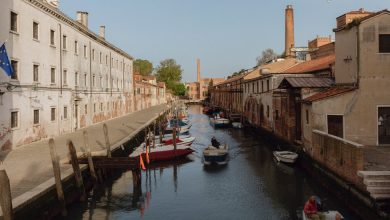We’ve Got to Stop Requiring Parking Everywhere

There are more registered vehicles in California than there are adult human beings. This isn’t especially anomalous — vehicles outnumber people who can drive them in much of the United States — but the mismatch is particularly absurd in the nation’s most populous and most car-obsessed state, where people and cars have long been locked in a largely invisible battle for the same precious resource: places to park themselves.
For California’s people, the problem is acute. In part because of a longtime undersupply of new housing, California’s cities are some of America’s least affordable places to live; less than 25 percent of households can afford to purchase a median-priced single-family home in the state.
Housing for cars, on the other hand, is abundant and cheap — often, it’s free for the taking. A recent study estimated that there are around 15 million parking spots in the San Francisco Bay Area. That’s nearly two spots for every person in the region, and 2.4 spots for every car. The Bay Area devotes about 20 percent of its incorporated land area to parking and roadways, a statistic that sounded unbelievable to me until I looked up the same number for Los Angeles County. Go up to the Griffith Observatory, near the Hollywood sign, and look out at the vast expanse of the city of angels. Then realize this: About 41 percent of everywhere the light touches is space for roads and parking. Los Angeles County devotes about 200 square miles of space — about nine Manhattans — for parking alone.
I wish I could tell you that California’s parking glut is an outlier, but it’s true in many parts of the country. And I wish I could say that all this space was lost inadvertently — that, as Joni Mitchell put it, you don’t know what you’ve got ’til it’s gone.
In fact, we paved paradise on purpose. After World War II, cities around the country adopted planning rules that required developers to build new automobile parking spots every time they built new places to live and work. These parking minimums have increased over time. In the 1930s, Los Angeles County required developers to build one parking space per single-family home; today, among other rules, the county requires two parking spaces per home, two per 2-bedroom apartment, one spot for every 250 square feet of retail space and one for every 400 square feet of office space.
Transportation experts have been calling attention to the disastrous effects of these rules for more than a decade, and in the last few years dozens of cities have eliminated or reformed their minimum-parking regulations. Now California, the state that in many ways set the standard for America’s car-dependent lifestyle, could be on the verge of reforming parking statewide. One bill moving through the state Legislature would prohibit cities from enforcing most minimum parking requirements near public transit, while a competing bill would give developers greater leeway in avoiding the rules. I hope legislators in my state adopt the former, stricter version of these measures, but even the more lenient one would be a significant improvement on the status quo, and would enshrine in our urban code a truth that has too long been ignored: Cities should be built for people, not cars.
There are many obvious arguments against minimum parking rules. Donald Shoup, a professor of urban planning at the University of California, Los Angeles, whose book “The High Cost of Free Parking” sparked much academic interest in the excesses of parking when it was first published in 2005, points out that the rules raise real estate costs. Parking is expensive — one study found that building-structured on-site parkingadded nearly $36,000 to the cost of building one unit of low-income housing in California. In some places these costs become truly staggering. TheWalt Disney Concert Hall, home to the Los Angeles Philharmonic, has a seating capacity of 2,265 in its main hall, and when it was completed in 2003 it had cost roughly $274 million to build. Its six-story underground parking garage has space for nearly as many cars — 2,188 — and cost an additional $110 million to build. That is, parking represented more than a quarter of the project’s nearly $400 million total cost.
You might argue that all this parking space is necessary — how else are people in a car-dependent metropolis like Los Angeles going to get to Disney Hall without driving and parking there? But by requiring parking spaces at every house, office and shopping mall — while not also requiring new bike lanes or bus routes or train stations near every major development — urban-planning rules give drivers an advantage in cost and convenience over every other way of getting around town. We need all that parking at Disney Hall because, thanks to all that parking, we’ve made driving the city’s default way of going anywhere.
There are other ways parking wrecks the urban fabric. It creates its own sprawl — the more endless, often empty parking lots between businesses, the less walkable and more car-dependent the city becomes. Because pavement sucks up ambient heat, parking also creates enormous urban “heat islands” that intensify the effects of global warming. And requiring parking worsens inequality. Because people whose income is less tend to drive less and use transit more, they’re essentially being forced to pay for infrastructure they don’t need — while wealthier car drivers get a break on the true costs of their car habit. “People who are too poor to own a car pay more for their groceries to ensure that richer people can park free when they drive to the store,” Shoup has written.
Laura Friedman, the California assembly member who authored AB 2097, the more far-reaching of the parking reform proposals, told me that her bill gives people an economic incentive to choose other ways to get around.
“We should be building housing that gives people a choice — you can have an apartment with one parking space for X dollars, with two spaces for more dollars, or with no spaces for fewer dollars,” she said.
Friedman’s bill recently passed the State Assembly, and now heads to the Senate. Its prospects there are uncertain. Last year a similar version of her bill never made it out of the Senate Appropriations Committee. This year, the chair of that committee, State Senator Anthony Portantino, has put forward his own parking bill. It would allow developers to skirt parking rules under certain conditions, including if they choose to build a certain number of affordable housing units in their projects. Portantino told me he thinks his bill offers more flexibility for city planners and developers. It recently passed the Senate, and now it heads to the Assembly.
The politics in California around housing and transportation are thorny.
Still, with two possible ways to curb the disaster of required parking, California is closer than ever to minimizing one of its worst urban mistakes. I hope lawmakers have the courage to get it across the finish line.
Office Hours With Farhad Manjoo
Farhad wants to chat with readers on the phone. If you’re interested in talking to a New York Times columnist about anything that’s on your mind, please fill out this form. Farhad will select a few readers to call.
The Times is committed to publishing a diversity of letters to the editor. We’d like to hear what you think about this or any of our articles. Here are some tips. And here’s our email: [email protected].
Follow The New York Times Opinion section on Facebook, Twitter (@NYTopinion) and Instagram.




